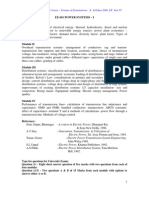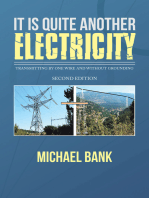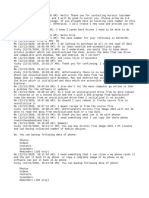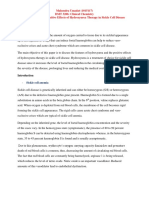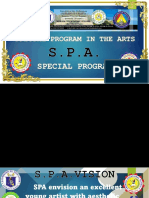Course: EX801 Computer-Aided Design of Electrical Machines: Departmental
Course: EX801 Computer-Aided Design of Electrical Machines: Departmental
Uploaded by
Shammi Shekhar ParmarCopyright:
Available Formats
Course: EX801 Computer-Aided Design of Electrical Machines: Departmental
Course: EX801 Computer-Aided Design of Electrical Machines: Departmental
Uploaded by
Shammi Shekhar ParmarOriginal Title
Copyright
Available Formats
Share this document
Did you find this document useful?
Is this content inappropriate?
Copyright:
Available Formats
Course: EX801 Computer-Aided Design of Electrical Machines: Departmental
Course: EX801 Computer-Aided Design of Electrical Machines: Departmental
Uploaded by
Shammi Shekhar ParmarCopyright:
Available Formats
PROGRAMME : BE Electrical & Electronics Engineering-VIII Semester
Course: EX801 Computer-Aided Design of Electrical Machines
CATEGORY OF COURSE COURSE TITLE Computer-Aided Design of Electrical Machines COURSE CODE EX801 CREDITS -6 C L 3 T 1 P 2 THEORY PAPERS Max.Marks-100 Min.Marks-35 Duration-3hrs.
Departmental
Course Contents
Unit-I Introduction: Design problem-Mathematical programming methods, computer aided design- Mathematical formulation of the problem. Programming techniques (LP & NLP only), Methods of solution, Unconstrained optimization problems, constrained optimization problems. Unit-II Optimal design of DC machine:-Design of armature, Windings and field systems, Selection of variables for optimal design, Formulation of design equations, Objective function, Constraint functions, Algorithms for optimal design. Unit-III Optimal design of power transformer:-Design of magnetic circuit, Design of windings, Selection of variables for optimal design, Formulation of design equations, Objective function, Constraint functions, Algorithms for optimal design. Unit-IV Optimal design for 3-phase alternator:-Design of stator, windings, Design of Field systems for salient pole and non-salient pole machines, Selection of variables for optimal design, Formulation of design equations, Objective function, Constraint functions, Algorithms for optimal design.
Unit-V Optimal design of 3-phase induction motor:-Design of stator, Windings Design of squirrel cage rotor, Design of slip ring rotor, Selection of variables for optimal design, Formulation of design equations, Objective functions Constraint functions, Algorithms for optimal design. References: 1. 2 3 4 5 . Computer- Aided Design of Electrical Equipment- by Dr. M. Ramamoorthy-Affiliated East-West press Pvt. Ltd. New Delhi. Electrical Machine Design- by A.K. Sawhney, Dhanpat Rai & Sons. Principles of Electrical Machine Design with Computer Programmes by- S.K. Sen, Oxford & IBH Publishing Co. Performance and Design of A.C. Machines-M.G. Say, Affiliated East West Press Pvt. Ltd., New Delhi. Performance and Design of D.C. Machines- Clayton & Hancock.
W.e.f. :- July-2010
Academic Session-2010-11
PROGRAMME : BE Electrical & Electronics Engineering-VIII Semester
Course: EX802 Electrical Drives
CATEGORY OF COURSE COURSE TITLE
Departmental
Electrical Drives
COURSE CODE EX802
CREDITS -6 C L 3 T 1 P 2
THEORY PAPERS Max.Marks-100 Min.Marks-35 Duration-3hrs.
Course Contents
Unit-I Control of D.C. motors by converters:- Introduction to Thyristor Controlled Drives, single phase semi and fully controlled converters and three semi and fully controlled converters connected to d.c. separately excited and d.c. series motors-continuous current operation, Output voltage and current waveforms, Speed and Torque expression, Speed-Torque Characteristics, Problems on converter fed d.c. motors. Unit-II Four quadrant operation of D.C. Drives.:Introduction to Four quadrant operation, Motoring operations, Electric braking, Plugging, dynamic and regenerative braking operations. Four quadrant operation of D.C. motor by Dual converters-Closed loop operation of DC motor (Block diagram only)Control of D.C. Motors by Choppers:-Single quadrant, Two-quadrant and four quadrant chopper fed d.c. separately excited and series excited motors, Continuous current operation, Output voltage and current waveforms-Speed torques expressions-Speed torque characteristics, Problems on Chopper fed d.c. motors, Closed loop operation (Block diagram only) Unit-III Control of Induction Motors on stator side:-Control of Induction Motor by AC Voltage controllersWaveforms, Speed torque characteristics, Variable frequency control of induction motor by Voltage Source, Current Source inverters and cycloconverters, PWM control Comparison of VSI & CSI operations, Speedtorque Characteristics, Numerical problems on induction motor drives, Closed loop operation of induction motor drives. (Block diagram only) Unit-IV Control of Induction Motors from rotor side:-Static rotor resistance control, Slip power recovery static Scherbius Drive, Static Kramer Drive, Their performance and speed torque characteristics advantagesapplication-problems. Unit-V Control of Synchronous Motors:- Separate control & Self control of synchronous motors, Operation of self controlled synchronous motors by VSI, CSI and Cycloconverters. Load commutated CSI fed Synchronous motor, Operation, Waveform, Speed torque Characteristics, Application, Advantage, Numerical problems, Closed loop operation os synchronous motors drives. (Block diagram only) References: 1. 2. 3. 4. 5. 6. 7. 8. 9. G.K. Dubey Fundamentals of Electrical Drives-. Narosa Publications Gopal K. Dubey Power semiconductor Controlled Drives- PHI S.B. Dewan, G.R. Slemon, A. Straughen Power semiconductor Controlled Drives B.K. Bose Power Electronic control of AC Drives. V. Subramanyam Thyristor control of Electric Drive Tata Mc Graw Hill Pub N.K. De , P.K. Sen Electric Drives PHI S.K. Pillai, A first course of Electrical Drive New age International. S.K. Pillai. Analysis of Thyristor Power conditioned Motors University Press (India)Ltd. Longman P.V. Rao, Power semiconductor Drives, BS Publications.
W.e.f. :- July-2010
Academic Session-2010-11
PROGRAMME : BE Electrical & Electronics Engineering-VIII Semester
Course: EX8301 Power Quality
CATEGORY OF COURSE COURSE TITLE
Power Quality
COURSE CODE EX8301
CREDITS -4 C L 3 T 1 P 0
THEORY PAPERS Max.Marks-100 Min.Marks-35 Duration-3hrs.
Course Contents
UNIT-I Introduction, power quality -voltage quality, power quality evaluations procedures term and definition: general classes of power quality problem, causes & effect of power quality disturbances. UNIT-II Voltage sags and interruption: sources of sags and interruption, estimating voltages sag performance, fundamental principles of of protection, monitoring sags. UNIT-III Transients over voltages: sources of transient over voltages, principles of over voltages protection, utility capacitor switching transients, fundamentals of harmonics and harmonics distortion, harmonics sources from commercial load and from industrial loads. UNIT-IV Applied harmonics : harmonics distortion evalutions, principles for controlling harmonics, harmonics studies devices for controlling harmonic distortion, filters, passive input filter standards of harmonics. UNIT-V Electro-magnetic compatibility, constant frequency control, constant tolerance band control, variable tolerance band control, discontinuous current control. Reference Books: 1. Power Quality- by R.C. Duggan 2. Power System harmonics by A.J. Arrillga 3. Power electronic converter harmonics by Derek A. Paice
W.e.f. :- July-2010
Academic Session-2010-11
PROGRAMME : BE Electrical & Electronics Engineering-VIII Semester
Course: EX8302 Advanced Communication Systems.
CATEGORY OF COURSE Departmental COURSE TITLE Advanced Communication Systems. COURSE CODE EX8302 CREDITS -4 C L 3 T 1 P 0 THEORY PAPERS Max.Marks-100 Min.Marks-35 Duration-3hrs.
Course Contents
Unit-I Introduction to spread spectrum modulation, Direct sequence (DS) spread spectrum, Spread spectrum with code division multiple access (CDMA), Ranging, Frequency hopping (FH) spread spectrum, PN sequence generation, Acquisition and tracking of FH signal and DS signals. Unit-II Satellite communication: Introduction to satellite communication, Frequency allocation active/passive synchronous ,Non synchronous systems, Orbits satellite attitude, Transmission path, Path loss, noise consideration link analysis, Satellite systems effective isotropic radiated power, Multiple access methods, Earth stations, Tracking and servo system, Up-down converters, Example of satellite systems. Unit-III Digital switching systems: Introduction to electronics and digital exchanges, Hierarchy of switching offices, Common control push button dialing systems, Switching matrix multiple stage switching time division multiplexing time slot interchanging (TSI), Comparison of TSI with space switching, Space array for digital signals, Combined space and time switching. Principles of FAX. Unit-IV Mobile communication: Introduction to cellular mobile communication element of the cellular systems, Cell design, hand off techniques, Frequency Management. Unit-V Local access networks: Improvement in convention cables: XDSL, ADSL, Wireless local loop, Fiber in local loop, radio Trunking. ISDN: Architecture, Services and Protocols, ATM networks
References: 1. 2. 3. 4. 5.
Radio Callins, Microwave communication. Gagldardi, Satellite communication. Thyggajan Vishwanathan, Digital switching systems. Lee, Cellular and mobile communication Karmile Fresher, Wireless digital communication.
W.e.f. :- July-2010
Academic Session-2010-11
PROGRAMME : BE Electrical & Electronics Engineering-VIII Semester
Course: EX8303 Fuzzy Logic & Neural Network
CATEGORY OF COURSE Departmental COURSE TITLE Fuzzy Logic & Neural Network COURSE CODE EX8303 CREDITS -4 C L 3 T 1 P 0 THEORY PAPERS Max.Marks-100 Min.Marks-35 Duration-3hrs.
Course Contents Unit-I Fuzzy system introduction, Fuzzy relation, Membership function, Fuzzy matrices and entropy, Fuzzy operation and composition. Unit-II Fuzzy Variables, Linguistic variables, measures of fuzziness, concepts of defuzzification, Fuzzy control applications. Unit-III Fundamentals of Artificial Neural networks- Biological prototype Artificial neuron, Activation functions, Single layer and multiplayer networks. Training Artificial neural networks, Preceptrons, Exclusive Or Problem Linear seperability, Storage efficiency, Preceptron learning, perceptron training algorithms. Back propagation, Training algorithm, network configurations, Network paralysis, Local minima, temporal instability. UNIT-IV Counter propagation networks, Kohonen layer, Training the kohonen layer, Pre processing the inputted vectors, Initialising the wright vectors, Statistical properties, Training the grosberg layer. Full counter propagation networks, Applications. Statistical methods, Boltzman training, Cauchy training, Artificial specific heat methods, Applications to general non-linear optimization problems. Back propagation and cauchy training. UNIT-V Hopfield nets, Recurrent networks, Stability, Associative memory, Thermodynamic systems, Statistical Hopfiled networks, Applications. Bi-directional associative memories, Retrieving on stored association, Encoding the associations. References : 1. 2. 3. 4. 5. 6. 7. 8.
Laurence Fausett Fundamentals of Neural Networks, Prentice Hall. Zmmermann H.J. Fuzzy Set Theory and its Applications, Allied Publishers Ltd. Klir G.J. and Folger T., Fuzzy Sets, Uncertainty and Information, Prentice Hall. Limin Fu. Neural Networks in Computer Intelligence, McGraw Hill. Zuroda J.M. Introduction to Artificial Neural Systems, Jaico Publishing. Haykin S. Artificial Neural Network: A Comprehensive Foundation Asia Pearson Pub. Sivanandam & Deepa- An Introduction to Neural Networks using Matlab 6.0 1st ed., TMH M.Amirthavalli, Fuzzy logic and neural networks, Scitech publications.
W.e.f. :- July-2010
Academic Session-2010-11
PROGRAMME : BE Electrical & Electronics Engineering-VIII Semester
Course: EX8401 SOFT COMPUTING TECHNIQUES AND APPLICATIONS
CATEGORY OF COURSE Departmental Electives COURSE TITLE
SOFT COMPUTING TECHNIQUES & APPLICATIONS
COURSE CODE EX8401
CREDITS -4 C L 3 T 1 P 0
THEORY PAPERS Max.Marks-100 Min.Marks-35 Duration-3hrs.
Course Contents
UNIT-1 Review of probability theory: Random variable, distribution functions , function of random variable. generation of random digit, and random variants from various distribution function, Monte Carlo simulation, sampling distributions station evolution using MCS, confidence interval, coefficient of variation. UNIT-2 Evolution ANN, artificial neurons, activation functions, ge propagation rule of training, RBF and FLN network. UNIT-3 Draw back of classical optimization techniques, genetic algorithm; binary and real parameter GA, constraints handling in GA. UNIT-4 Evolution strategies(ES), two members non-recombinative ES, multi member ES, recombinative ES. Optimization based on swarm intelligence particle, swarm optimization and its variants . UNIT-5 Application of soft computing techniques to problem of electrical engg. E.g. economic dispatch, reliable optimization, ANN traing using evolutionary algorithms. References : - rule, and back
1. R.Y. Rubinstein Simulation and the Monte Carlo method, John Wiley & sons 1st Edition. 2 Paul. L. Mayer-Introducing probability and statical application, Addition Weslay. 3 Rajasekaran and pai- Neural Network, Fuzzy logic & Genetic Algorithms. PHI Learing 4 LiMin. Fu, Neural Networks in Computer Intelligence, 9th Reprint TMH 5 Multi objective optimization using evolutionary algorithm- Kalyanmoy Deb John Wiley & Sons Ltd. 6 Probability and Random processes for Electrical Engineering , Alberto Leon Garcia IInd Pearson . 7 Principles of soft computing- S N Shivanandan, S N Deepa Wiley India (P) Ltd, I edition 2007. 8 Hand book of genetic algorithm- Rajaserkharans, vijaya laxmi pai. 9 PSO Tutorial- Kennedy Ebuehart. 10 Sivanandam & Deepa- An Introduction to Neural Networks using Matlab 6.0 1st ed., TMH 11 M.Amirthavalli, Fuzzy logic and neural networks, Scitech publications.
W.e.f. :- July-2010
Academic Session-2010-11
PROGRAMME : BE Electrical & Electronics Engineering-VIII Semester
Course: EX8402 Digital Electronics & Logic Design-II
CATEGORY OF COURSE Departmental COURSE TITLE Digital Electronics & Logic Design II COURSE CODE EX8402 CREDITS -4 C L 3 T 1 P 0 THEORY PAPERS Max.Marks-100 Min.Marks-35 Duration-3hrs.
Course Contents
Unit I Specification of sequential systems: Characterizing equation & definition of synchronous sequential machines. Realization of Floatable from verbal description, Mealy and Moore model machines state table and transition diagram. Minimization of the flow table of completely and incompletely specifies sequential machines Unit II High level description and specification of standard combinational & sequential modules and introduction to VHDL Programming. Concept of iterative arrays. Unit III Secondary state assignments in sequential machine; parallel & serial decomposition of equential machines. Introduction to asynchronous sequential machine, races and hazards. Information loss-less machine. Unit IV Algorithmic state machine and fundamental concept of hardware / firmware algorithms. Controllers and data system designing. Unit V Concept of PROM, PLE and FPLA. PALASM / XYLINGS software applications. Other PLD devices like EPLA, GAL, PHEEL, Mega PAL and Hard Array Logic. Books : 1. 2. 3. 4. 5. 6. 7. 8. 9. Z. Kohavi Switching & Finite Automata Theroy TMH. S. C. See Digital Circuits and Logic Design PHI, M.K. Ercegovac & T. Lang, Digital Systems and Hardware/Firmware Algorithms John Wiley. Stefan Sjoholm & Lennart Lind VHDL for Designers Prentice-Hall. P.J. Ashenden The Designers Guide to VHDL Harcourt Asia PTE Ltd. M. Ercegovac et.al Introduction to Digital Systems M. Mano Digital Design John Wiley & Sons, PHI. P.K. Lala Digital System Design using Programmable logic Devices BS Publication K.L.Short Microprocessors and Programmed Logic PHI. Z. Navatri VHDL Analysis & Modeling of Digital Systems Mc-Graw Hill.
W.e.f. :- July-2010
Academic Session-2010-11
PROGRAMME : BE Electrical & Electronics Engineering-VIII Semester
Course: EX8403 Digital Image Processing
CATEGORY OF COURSE Departmental COURSE TITLE Digital Image Processing COURSE CODE EX8403 CREDITS -4 C L 3 COURSE CONTENTS T 1 P 0 THEORY PAPERS Max.Marks-100 Min.Marks-35 Duration-3hrs.
Unit-I Digital Image Processing-Elements of a Digital Image Processing system, Structure of the Human eye, Image formation and contrast sensitivity, Sampling and Quantization, Neighbours of a pixel, Distance measures, Photographic file structure and exposure, Filem characteristics, Linear scanner, Video camera, Image processing applications. Unit-II Image Transforms- Introduction to Fourier transform-DFT, Properties of two dimensional FT, Separability, Translation, Periodicity, Rotation, Average value, FFT algorithm, Walsh transform, Hadamard transform, Discrete Cosine transform. Unit-III Image Enhancement- Definition, Spatial domain methods, Frequency domain methods, Histogram modification technique, Neighborhood averaging, Media filtering, Lowpass filtering, Averaging of multiple images, Image sharpening by differentiation and high pass filtering. Unit-IV Image Restoration-Definition, Degradation model, Discrete formulation, Circulant matrices, Block circulant matrices, Effect of diagnolization of circulant and block circulant matrices, Unconstrained and constrained restorations , Inverse filtering, Wiener filter, Restoration in spatial domain. Unit-V Image Encoding-Objective and subjective fidelity criteria, Basic encoding process, The mapping, The quantizer, The coder, Differential encoding, Contour encoding, Run length encoding, Image encoding relative to fidelity criterion, Differential pulse code modulation. Unit-VI Image Analysis and Computer Vision- Typical computer vision system, Image analysis techniques, Spatial feature extraction, Amplitude and Histogram features, Transform features, Edge detection, Gradient operators, Boundary extraction, Edge linking, Boundary representation, Boundary matching, Shape representation. References: 1. 2. 3. 4. Rafael, C. Gonzlez., and Paul, Wintz, Digital Image Processing, Addison-Wesley Publishing Company. Jain Anil K., Fundamentals of Digital Image Processing, Prentice Hall. Sosenfeld, and Kak, A.C., Digital Image Processing, Academic Press. William K. Pratt., Digital Image Processing, John Wiley and Sons.
W.e.f. :- July-2010
Academic Session-2010-11
PROGRAMME: B.E. Electrical & Electronics VIII-Semester
Course: EX803 Major Project
CATEGORY OF COURSE Departmental
COURSE TITLE
COURSE CODE
EX803
CREDIT-8C L 0 T 0 P 8
PRACTICAL EXMN.
Max.Marks-100
Major Project
Min.Marks-50
COURSE GUIDELINES
The objectives of the course Major Project are To provide students with a comprehensive experience for applying the knowledge gained so far by studying various courses. To develop an inquiring aptitude and build confidence among students by working on solutions of small industrial problems. To give students an opportunity to do some thing creative and to assimilate real life work situation in institution. To adapt students for latest developments and to handle independently new situations. To develop good expressions power and presentation abilities in students. The focus of the Major Project is on preparing a working system or some design or understanding of a complex system using system analysis tools and submit it the same in the form of a write-up i.e. detail project report. The student should select some real life problems for their project and maintain proper documentation of different stages of project such as need analysis, market analysis, concept evaluation, requirement specification, objectives, work plan, analysis, design, implementation and test plan. Each student is required to prepare a project report and present the same at the final examination with a demonstration of the working system (if any). The faculty and student should work according to following schedule: i) Each student undertakes substantial and individual project in an approved area of the subject and supervised by a member of staff. ii) The student must submit outline and action plan for the project execution (time schedule) and the same be approved by the concerned faculty. iii) At all the steps of the project, students must submit a written report of the same.
W.e.f. :- July-2010
Academic Session-2010-11
PROGRAMME : BE Electrical & Electronics Engineering-VIII Semester
Course: EX804 Industrial Project
CATEGORY OF COURSE COURSE TITLE Industrial project
Departmental
COURSE CODE EX804
CREDITS -2 C L 0 T 0 P 2
PRACTICAL EXAM Max.Marks-50 Min.Marks-25 Duration-3hrs.
Concept and guideline Student will under take a small project which will pertain to live problems of Industry\ Community. The project may be related to use of technology in industry or transfer of technology to introduce value addition for agriculture, improving health & hygienic, energy management & conservation, optimal use of local resources or in the new product areas. The student can undertake project singly or in a batch (of not more than five students). At the end of project student will submit a project report which will contain details of the problem identified and solution suggest for it.
W.e.f. :- July-2010
Academic Session-2010-11
You might also like
- Bread-Types of Bread & UsesDocument21 pagesBread-Types of Bread & UsesHarish SrinivasanNo ratings yet
- Ex 8 Sem SyllabusDocument6 pagesEx 8 Sem SyllabusMayank KatariaNo ratings yet
- Electrical and Electronics Engg. B.Tech. Semester-Vii: Course Code Course Title L T P CreditsDocument26 pagesElectrical and Electronics Engg. B.Tech. Semester-Vii: Course Code Course Title L T P CreditsAbhishek Kumar ChambelNo ratings yet
- CBGS 8 Sem050318033746 PDFDocument9 pagesCBGS 8 Sem050318033746 PDFshashank barsainyaNo ratings yet
- AKU Patna Syllabus 3rd YearDocument20 pagesAKU Patna Syllabus 3rd Yearडाँ सूर्यदेव चौधरीNo ratings yet
- UNIT - I:Basic Concepts of Electric Drives:: Motor Mechanism DynamicsDocument6 pagesUNIT - I:Basic Concepts of Electric Drives:: Motor Mechanism DynamicsRam DinNo ratings yet
- Power SystemDocument22 pagesPower SystemVenkat RamanNo ratings yet
- EEE 4-1 SyllubusDocument10 pagesEEE 4-1 SyllubusSai ChanduNo ratings yet
- Bput 2-4 Yr It SyllabusDocument45 pagesBput 2-4 Yr It SyllabusSankarsan SahooNo ratings yet
- Detailed Syllabus FOR 5 Semester: Anpat Niversity U. V. Patel College of Engineering Ganpat Vidyanagar, Kherva-382711Document10 pagesDetailed Syllabus FOR 5 Semester: Anpat Niversity U. V. Patel College of Engineering Ganpat Vidyanagar, Kherva-382711Maulik SharmaNo ratings yet
- EEEPER18 SyllabusDocument32 pagesEEEPER18 Syllabusమీ ఫ్రెండ్ కిట్టుNo ratings yet
- B. E. Sem Vi (Electrical) E-601: Electrical Machines - IiiDocument10 pagesB. E. Sem Vi (Electrical) E-601: Electrical Machines - IiibaruaeeeNo ratings yet
- EED M.tech SyllabusDocument28 pagesEED M.tech SyllabusAthiesh Kumar100% (1)
- Ee001 Power Generation Systems: L T P CDocument32 pagesEe001 Power Generation Systems: L T P CPARTH DAVENo ratings yet
- Nit 3Document11 pagesNit 3Er Paramjit SinghNo ratings yet
- Electrical and Electronics Engineering .: 8 Semester SyllabusDocument7 pagesElectrical and Electronics Engineering .: 8 Semester Syllabusshankey12No ratings yet
- Eee - R2019 - SyllabusDocument6 pagesEee - R2019 - SyllabusVishnuNo ratings yet
- Electrical and Electronics 2006 Sem VIDocument7 pagesElectrical and Electronics 2006 Sem VIRohithnarayanNo ratings yet
- Amie Syllabus Sec B ElectricalDocument19 pagesAmie Syllabus Sec B ElectricalvenkatNo ratings yet
- CBGS 7 Sem 20-21290521110137Document18 pagesCBGS 7 Sem 20-21290521110137kushagra vashishthaNo ratings yet
- Scheme: Paper-1 General Studies & Mental AbilityDocument2 pagesScheme: Paper-1 General Studies & Mental AbilityRajashekar ReddyNo ratings yet
- EX-701 Utilization of Electrical EnergyDocument10 pagesEX-701 Utilization of Electrical EnergyVikesh gondNo ratings yet
- Mtech PS SyllabusDocument25 pagesMtech PS SyllabusJithendra NathNo ratings yet
- JFTTRHGHMJBDocument21 pagesJFTTRHGHMJBBikash Ranjan DashNo ratings yet
- Sastra Universiy: B.Tech (Eee) ProgrammeDocument13 pagesSastra Universiy: B.Tech (Eee) ProgrammeSriram VenkatachariNo ratings yet
- Electrical Machine-II: Course Contents (Uec Scheme)Document6 pagesElectrical Machine-II: Course Contents (Uec Scheme)Ram DinNo ratings yet
- Department of Electrical Engineering: M.Tech. ProgramsDocument17 pagesDepartment of Electrical Engineering: M.Tech. ProgramsSidali ChaibNo ratings yet
- FOR Electrical & Electronics Engineering: CurriculumDocument10 pagesFOR Electrical & Electronics Engineering: Curriculumdivyanshuranjan9973No ratings yet
- BE VII Sem Electrical Engg JEC JabalpurDocument13 pagesBE VII Sem Electrical Engg JEC JabalpursvmgrgNo ratings yet
- 3rd Semester Electrical SyllabusDocument4 pages3rd Semester Electrical SyllabusHimanshu MalviyaNo ratings yet
- Be EeeDocument38 pagesBe EeeGopinathblNo ratings yet
- 5th SEMDocument10 pages5th SEMChandra SekaranNo ratings yet
- Sem6 SyllabusDocument5 pagesSem6 SyllabusSamsung TabletNo ratings yet
- Eee Polytechnic Engineering-Power Electronics Semester 6 Text BooksDocument90 pagesEee Polytechnic Engineering-Power Electronics Semester 6 Text Bookschandu badavathNo ratings yet
- EE Engg. 6 Sem.Document15 pagesEE Engg. 6 Sem.krishna universityNo ratings yet
- BE Electrical Engineering Syllabus Final Draft As On 13 FebDocument37 pagesBE Electrical Engineering Syllabus Final Draft As On 13 Febviren72No ratings yet
- CC C CCC C C C C - C - !" #$%!&' !! - : Paper-2 (Concerned Subject) Electrical EngineeringDocument3 pagesCC C CCC C C C C - C - !" #$%!&' !! - : Paper-2 (Concerned Subject) Electrical EngineeringRamadugula Rama Subrahmanya VenkateswararaoNo ratings yet
- EE1101Document2 pagesEE1101balajiNo ratings yet
- Elecives CombinedDocument32 pagesElecives CombinedmeetNo ratings yet
- Period Per Week Credits Maximum Marks Theory Practical Total MarksDocument4 pagesPeriod Per Week Credits Maximum Marks Theory Practical Total Markswolverine 3No ratings yet
- B techecesyllabusOLDDocument61 pagesB techecesyllabusOLDNevil BastiansunnyNo ratings yet
- FRM Download FileDocument16 pagesFRM Download Fileakash2003bhardwajNo ratings yet
- EEE R13 IV-I - Revised As On 09-08-16Document25 pagesEEE R13 IV-I - Revised As On 09-08-16Sheikh Noor MohammadNo ratings yet
- TE Electronics Syllabus Wef 14 15 - 27 4 15Document36 pagesTE Electronics Syllabus Wef 14 15 - 27 4 15saurabhm6No ratings yet
- Sixth SemesterDocument13 pagesSixth SemesterSaurabh TiwariNo ratings yet
- JNTUK DAP Course Structure and Syllabus EEE II YEAR R10 Students 3Document32 pagesJNTUK DAP Course Structure and Syllabus EEE II YEAR R10 Students 3Shravan RaoNo ratings yet
- Eee III Year-Be-2012Document14 pagesEee III Year-Be-2012Sridhar Panthangi NaneeNo ratings yet
- KU Electrical Engineering 5th Semester GuideDocument37 pagesKU Electrical Engineering 5th Semester GuideSreerag Kunnathu SugathanNo ratings yet
- Curriculum For MTech in Power Systems ProgrammeDocument20 pagesCurriculum For MTech in Power Systems ProgrammeheerapotterNo ratings yet
- Bee IliyasDocument3 pagesBee Iliyassr2846877No ratings yet
- Sylla PDFDocument50 pagesSylla PDFGiju PaulNo ratings yet
- Mtech Eee2011Document30 pagesMtech Eee2011vinayaka_murugan100% (1)
- Power Electronics: Lecture Notes of Power Electronics CourseFrom EverandPower Electronics: Lecture Notes of Power Electronics CourseNo ratings yet
- Power Electronics and Energy Conversion Systems, Fundamentals and Hard-switching ConvertersFrom EverandPower Electronics and Energy Conversion Systems, Fundamentals and Hard-switching ConvertersNo ratings yet
- Electrical Machines: Lecture Notes for Electrical Machines CourseFrom EverandElectrical Machines: Lecture Notes for Electrical Machines CourseNo ratings yet
- Methods for Increasing the Quality and Reliability of Power System Using FACTS DevicesFrom EverandMethods for Increasing the Quality and Reliability of Power System Using FACTS DevicesNo ratings yet
- Wireless Power Transfer for Electric Vehicles: Foundations and Design ApproachFrom EverandWireless Power Transfer for Electric Vehicles: Foundations and Design ApproachNo ratings yet
- It Is Quite Another Electricity: Transmitting by One Wire and Without GroundingFrom EverandIt Is Quite Another Electricity: Transmitting by One Wire and Without GroundingNo ratings yet
- Complete Clinical Guide To Cardiology 1st Edition Christian Fielder Camm PDF For All ChaptersDocument62 pagesComplete Clinical Guide To Cardiology 1st Edition Christian Fielder Camm PDF For All Chaptersarrianadife100% (4)
- Fungsi If Else If Else Dan Array Pada PeDocument4 pagesFungsi If Else If Else Dan Array Pada Pefaisal robbyNo ratings yet
- 6 - Breeding Corn For Two Traits - SS 6 - 2Document2 pages6 - Breeding Corn For Two Traits - SS 6 - 2Loura MalinaoNo ratings yet
- Acronis True Image 2021Document2 pagesAcronis True Image 2021Erik BarnesNo ratings yet
- Hydroxyurea For Sickle Cell DiseaseDocument8 pagesHydroxyurea For Sickle Cell DiseaseMahendra Vic UmadatNo ratings yet
- Components Guide - Access Control ListsDocument3 pagesComponents Guide - Access Control ListssautorrentNo ratings yet
- CGC Activities On Climate Change Issues: Ahsan Uddin AhmedDocument12 pagesCGC Activities On Climate Change Issues: Ahsan Uddin AhmedSuhan ChowdhuryNo ratings yet
- Tiltmeters and Tilt Beams User Manual en 04 19Document21 pagesTiltmeters and Tilt Beams User Manual en 04 19tiferniaNo ratings yet
- Alcatel Lucent DatasheetDocument12 pagesAlcatel Lucent DatasheetBanzragch JamsranNo ratings yet
- Special Program in The ArtsDocument30 pagesSpecial Program in The Artsnestor castanos jrNo ratings yet
- Barabtarlo - Nabokovs Reliquary PoemDocument8 pagesBarabtarlo - Nabokovs Reliquary PoemKebab TvrtkićNo ratings yet
- RTB Booklet PrintDocument12 pagesRTB Booklet PrintNGAMIJENo ratings yet
- Welding Joint Design & Welding Symbols - Chapter #5Document21 pagesWelding Joint Design & Welding Symbols - Chapter #5JACKMAAAANo ratings yet
- Dragon Masters 2 Comprehension QDocument2 pagesDragon Masters 2 Comprehension QKaren GordonNo ratings yet
- Trade Fair by Nitish AroraDocument25 pagesTrade Fair by Nitish Aroranitisharora116No ratings yet
- q3j Week 4 Lesson in PPT 2 Propaganda Devices YesDocument52 pagesq3j Week 4 Lesson in PPT 2 Propaganda Devices Yesdivinagracias abadNo ratings yet
- Airbus A320-214 Cebu Pacific Special StickerDocument17 pagesAirbus A320-214 Cebu Pacific Special StickermaverickbarsaloteNo ratings yet
- Car Scanner OBD2Document104 pagesCar Scanner OBD2joejondNo ratings yet
- Pediatric Mechanical Circulatory SupportDocument8 pagesPediatric Mechanical Circulatory SupportselvakumarNo ratings yet
- Digital Trip Relay: 2. Externals and ConfigurationDocument1 pageDigital Trip Relay: 2. Externals and ConfigurationSandhi YudiyantoNo ratings yet
- Summer Project On Challanges Faced by BBA Students After Completion of BBADocument52 pagesSummer Project On Challanges Faced by BBA Students After Completion of BBAsushrampradhanNo ratings yet
- COBB Brooding GuideDocument14 pagesCOBB Brooding GuideAhmed NickovNo ratings yet
- Govpub CS1Document856 pagesGovpub CS1RogerNo ratings yet
- Guidelines For Historic Bridge Rehabilitation and ReplacementDocument66 pagesGuidelines For Historic Bridge Rehabilitation and Replacementdapinmin100% (1)
- FSTC 381-4012, Typical Foreign Unconventional WeaponsDocument54 pagesFSTC 381-4012, Typical Foreign Unconventional WeaponsВладимир Конев100% (2)
- Epaper 2 February 2023Document19 pagesEpaper 2 February 2023Strive MarimoNo ratings yet
- API 610 Pump Selection and Curve EvaluationDocument4 pagesAPI 610 Pump Selection and Curve Evaluationbbmoksh100% (1)
- Term Paper Unemployment in The PhilippinesDocument5 pagesTerm Paper Unemployment in The Philippinesakjnbowgf100% (1)
- TOEFL iBTDocument43 pagesTOEFL iBTsuponova.nilufarNo ratings yet

















